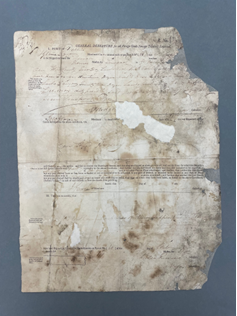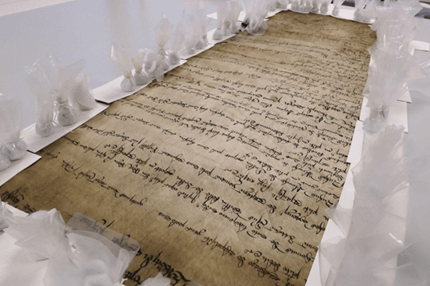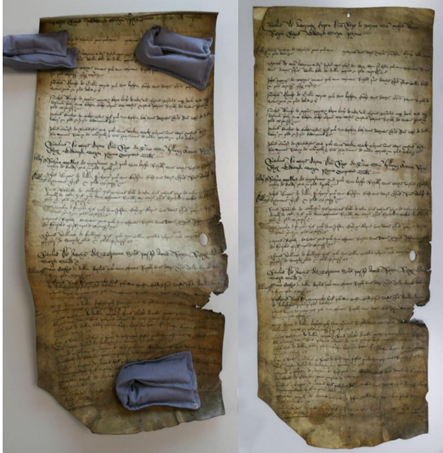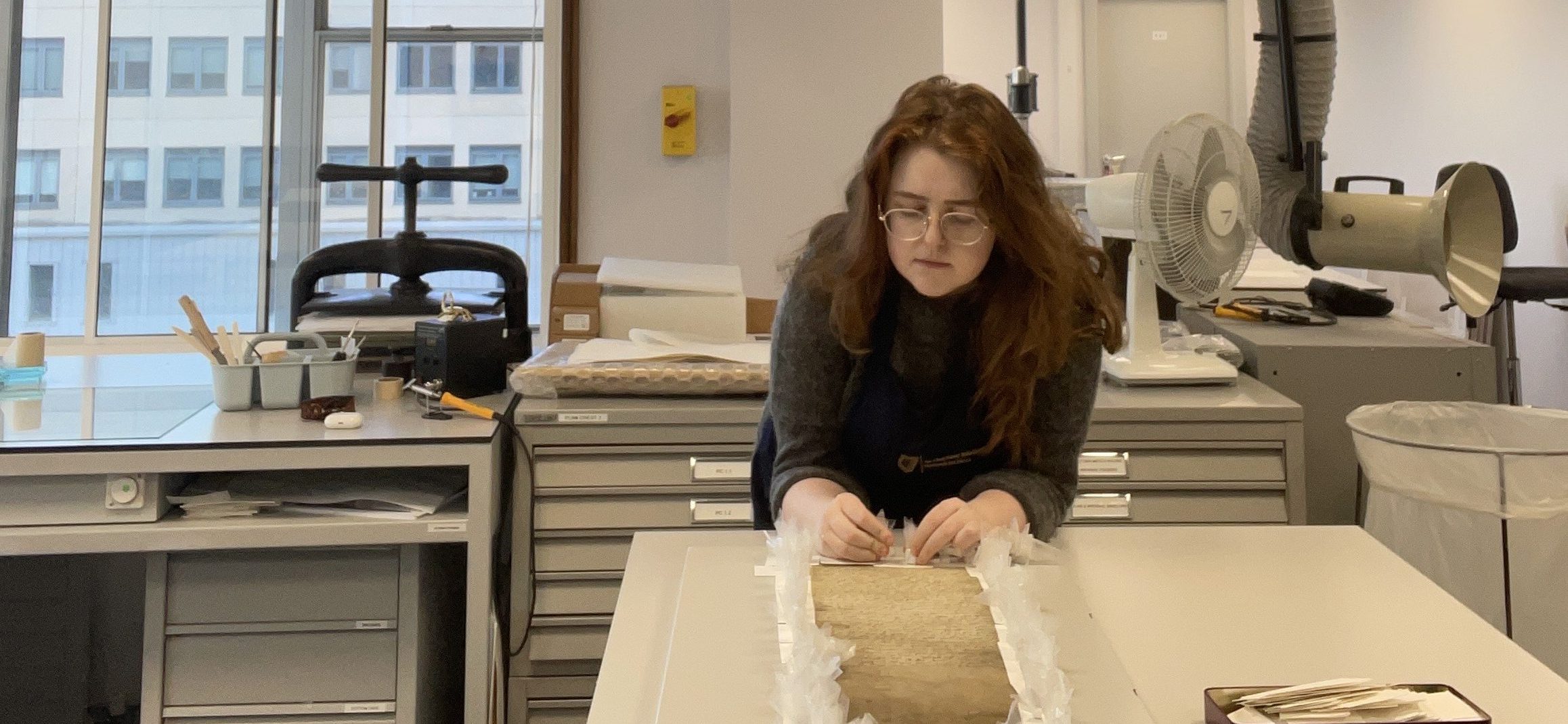After completing the first year of my MA in Conservation Studies at West Dean College in 2023, I was fortunate enough to take up a placement at the National Archives, Ireland (NAI), generously funded by the Virtual Record Treasury of Ireland (VRTI).
On the 30th of June 1922, the Public Record Office of Ireland (PROI) was destroyed, an early casualty of the Irish Civil War. The surviving documents, rescued from the rubble of the building, make up the Salved Records Collection. My six-week placement focused on conserving a range of paper and parchment documents from this important collection, so that they might be safely imaged and added to the digitally reconstructed archive. It provided the opportunity to learn new techniques to treat the serious damage wrought by the fire, smoke and collapse of the PROI building.
These techniques allowed me to tackle the challenges of dealing with severely damaged documents. I was so struck by what I learnt that I spent the second year of my MA developing a method to evaluate fire damage in parchment. This later became the basis for my dissertation. After a year away from NAI, I was delighted to be offered a second placement to continue my work with the Salved Records Collection in October 2024. This time, I spent eight weeks working on the collection as a new graduate!
Again, I was beyond fortunate to find myself conserving challenging materials in a well-equipped, supportive setting. Access to resources and expertise meant I could cater to the specific materiality and damage of the salvaged documents. Everything I worked on had been recovered from the rubble of the PROI and represented a wide array of damage. Conservation is often described as a holistic practice. Every object is different, and treatment approaches have to be carefully considered to achieve the best possible outcome.
Dublin Port: Drawbacks and Bounties
The first selection of documents I worked on were two sets of large format papers for Dublin Port, dated 1818. One set (35 documents) details bounties paid on shipments of Irish linen. The second set (53 documents), in a similar format, related to the refund of port duties (“drawbacks”) on shipments passing through the port. As revenue accounts, these are significant documents detailing the development and history of Dublin Port.

I carried out initial surface cleaning using soft Japanese brushes and vulcanised rubber sponges, to remove as much surface dirt and debris as possible. Then the documents were washed in batches. I interleaved the sheets between layers of release material and submerged them in a water bath. The batches rested in the bath for around two hours, before I gently lifted them out and put them into fresh water. After another two hours, they could be separated from one another and allowed to dry.
Washing creates an immediate visible difference in the material, reducing staining, relaxing stubborn creasing and lifting dirt from the paper. Washing also restores strength and flexibility to the paper, making it safer to handle and repair. The drying process naturally creates undulations in the paper as it contracts and relaxes, so the documents were then humidified and pressed as needed.
Once dry, it was time to start repairs. I repaired splits and tears in the paper using a lightweight Japanese tissue, toned to be similar in colour to the original material and wheat starch paste adhesive. Where required, infills of a suitable weight Japanese paper were shaped to areas of loss and fitted with careful repairs.
Once conserved, both sets of documents were rehoused in folders for safe storage and access.

Kings Bench Plea Roll (NAI KB 1/5)
This parchment roll (composed of 9 individual membranes) is a collection of court documents from the King’s Bench, dating from 1608 (Mid-Tudor period). According to Irish Record Commission’s inventory of plea rolls, this roll was damaged prior to the 19th century, with only these nine membranes surviving by 1819.
Parchment is a tricky material. Made from stretched and treated animal skin, it can be incredibly long lasting, but it is also highly sensitive to environmental changes. It especially reacts to changes in temperature and humidity. Too dry, and it can become dangerously brittle. Too wet or too hot, and the fibres become gelatinised- irreversibly damaged. Once gelatinised, the parchment can no longer hold moisture. Parchment also has a strong “memory”, when a parchment document has been rolled for a long time, it becomes difficult to unroll.
The parchment had become highly brittle over time and couldn’t be digitised in its rolled format. I carefully unrolled the membranes one at a time and gently cleaned each document to remove surface dirt. I then used the specialised humidification chamber to expose them to controlled humidity over 6-8 hour periods.

Once the parchment had absorbed an appropriate level of moisture, I could use magnets to apply localised tension and encourage the membrane to flatten. Several of the documents were extremely embrittled and required multiple rounds of humidification and flattening.
The treatment was extremely effective. After flattening, a second cleaning was carried out to remove further surface dirt before Japanese tissue in a similar tone was used to repair vulnerable tears. Now cleaned, flattened and repaired, the documents are safe to handle and to undergo digitisation. As a final step, I rehoused each membrane in individual clear mylar sleeves to allow for easy storage and handling.

By the end of my placement, the collection of documents from Dublin Port and the Kings Plea Roll were both safely conserved and stored, ready to be digitised.
I would like to express my sincere gratitude to both VRTI and NAI for providing the opportunity to preserve these documents for the future, as well as the opportunity for supported professional development. The work placements have had a huge impact on my educational and professional journey, and I am so grateful to have been afforded it.
